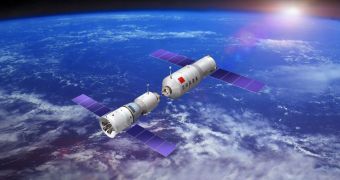According to the Chinese state-run news agency Xinhua, the China National Space Administration (CNSA) plans to launch its first test module of a new space station next week. The exact launch date was not provided, but authorities say that it will be sometime between September 27-30.
The announcement was made yesterday, September 20. Xinhua reported that the Heavenly Palace spacecraft (Tiangong-1) will represent the first stepping stone in an ambitious project to complete the first Chinese orbital facility by 2020.
Over the past few years, the country's space ambitions have grown proportionally to its status as a global economic power. CNSA launched a couple of lunar missions during this interval, and also carried out its first manned spaceflight and spacewalk to low-Earth orbit.
Currently, it plans to test its orbital rendezvous capabilities. The first such meet-up is scheduled to occur in 2012. If successful, the space agency will then proceed towards building several more modules, and deploying them to space according to a very packed launch manifest.
Plans call for the Chinese space station to weigh about 60 tons. For comparison, the International Space Station – which took numerous countries 11 years and $100 billion to build – has a mass of about 450 tons (990,000 pounds), Space reports.
Tiangong-1 will launch aboard a Long March 2F delivery system, from the Jiuquan Satellite Launch Center (JSLC), in Gansu province, northwestern China. The orbital module has already been integrated with its carrier rocket, and the latter moved to its launch pad.
Xinhua reports that the launch should have occurred by now, but was delayed by the failure of a Long March 2C delivery system last month. The mission was carrying an experimental satellite to orbit.
“Every main system is standing by and the final preparations are running smoothly,” the space agency quotes an unmanned CNSA spokesperson as saying. Over the next few days, engineering teams at the JSLC will complete final testing of both booster and spacecraft.
After being deployed in a stable orbit, Tiangong-1 will await the launch of the unmanned Shenzhou 8 spacecraft. The two will then attempt to meet up and dock with each other in space, the first time China attempts such an intricate and delicate maneuver.
The 8.5-ton Tiangong-1 will also be carrying engineering and medical experiments, which will enable it to return important scientific data before the docking attempt.

 14 DAY TRIAL //
14 DAY TRIAL //